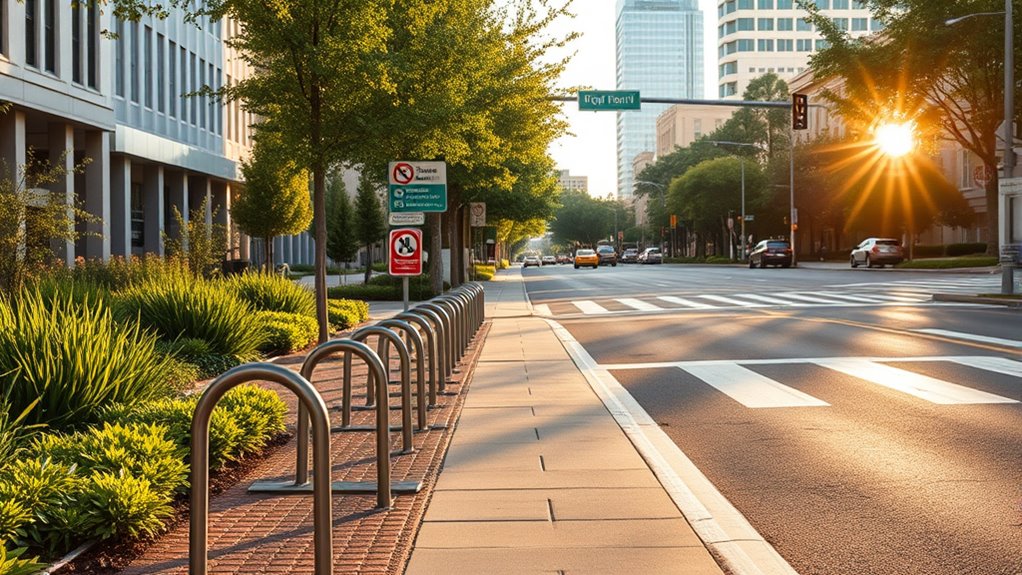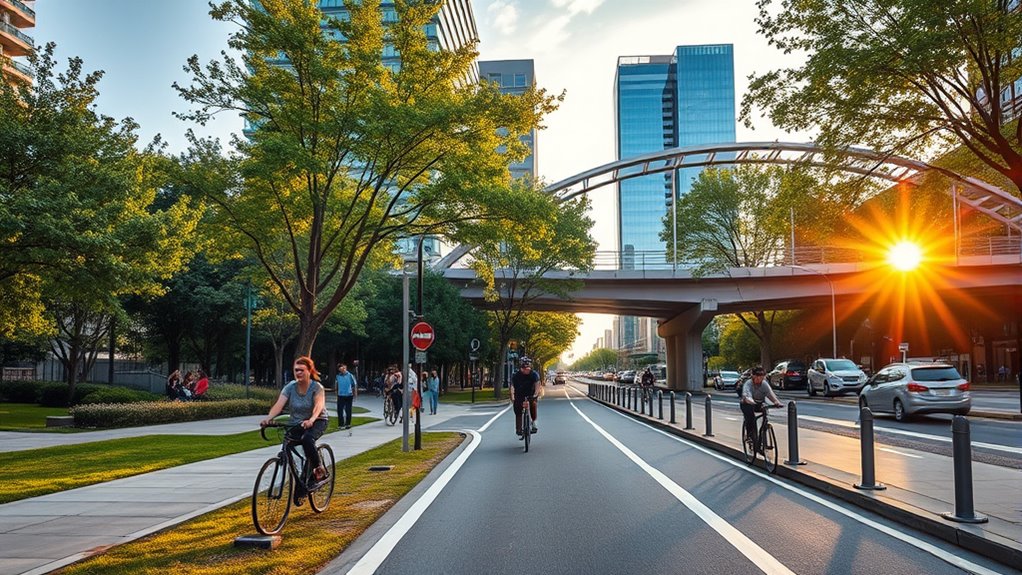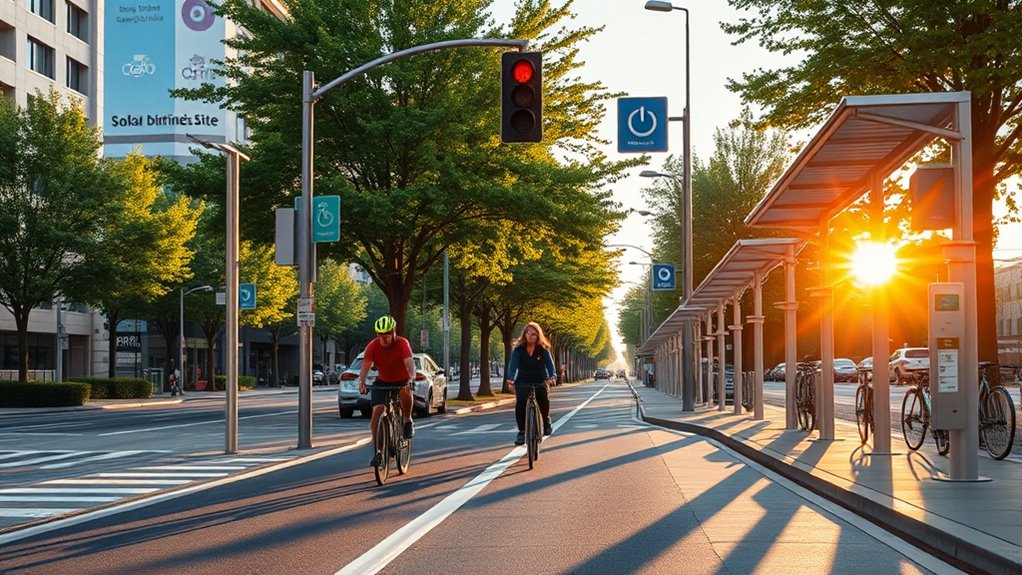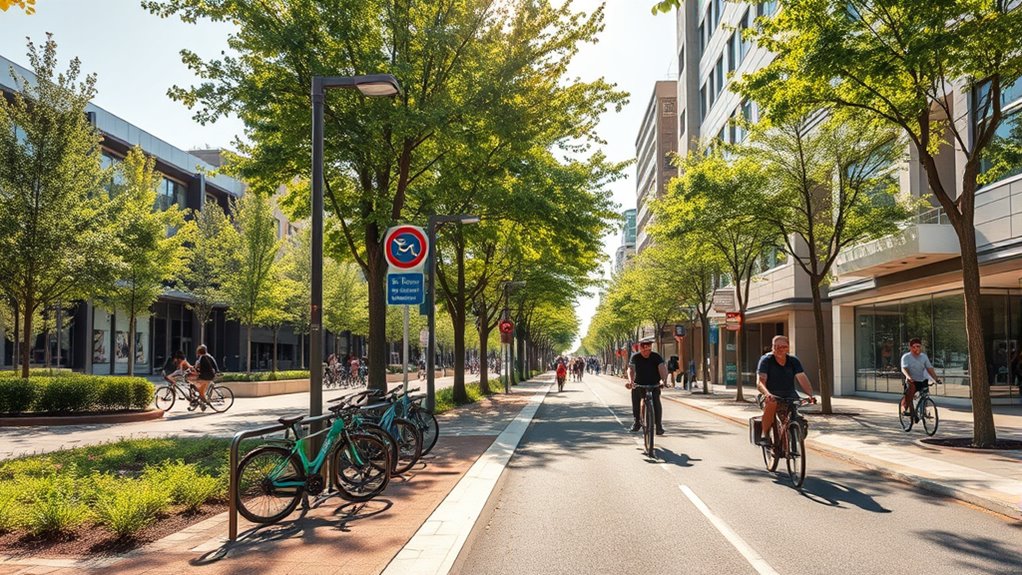To plan bike-friendly urban infrastructure, focus on creating dedicated, protected lanes that physically separate cyclists from motor vehicles, especially at intersections. Design continuous, connected networks linking key destinations like transit stations and schools, and include secure parking options for practicality. Engage the community through public workshops and gather data on traffic patterns to optimize safety and flow. By understanding successful city examples and innovative strategies, you’ll find practical steps that make biking safer and more appealing—keep exploring to learn more.
Key Takeaways
- Design dedicated, protected bike lanes and intersection treatments to physically separate cyclists from motor traffic.
- Ensure continuous, connected cycling networks linking transit hubs, schools, and commercial areas.
- Incorporate high-quality surfaces, clear signage, and ample bike parking to enhance safety and convenience.
- Engage communities through workshops, group rides, and feedback to align infrastructure with local needs.
- Utilize data and innovative tools like sensors and tactical urbanism to prioritize improvements and monitor safety.
Key Elements of Effective Bicycle Infrastructure

Effective bicycle infrastructure relies on essential features that guarantee safety and convenience for riders. Dedicated lanes and protected bike paths are vital, as they physically separate cyclists from motor vehicles, reducing accidents. Intersection treatments that separate cyclists from traffic further improve safety. High-quality bike facilities should have smooth surfaces, clear signage, and enough width to accommodate riders of all skill levels comfortably. Incorporating bike parking, like secure racks and large storage areas, makes cycling a practical transportation option. Urban planning standards emphasize creating continuous, connected bike networks linking key destinations such as transit stations, schools, and commercial centers. When these elements come together, bike infrastructure becomes safer, more accessible, and encourages more people to choose cycling as their primary mode of transport.
Successful Examples From Leading Cities

Leading cities around the world have implemented innovative bike infrastructure projects that set inspiring examples for urban planners. Copenhagen’s investment in bike bridges and urban redesign has led to about 62% of residents commuting by bike, reducing greenhouse gas emissions. Amsterdam’s 2019 plan to expand parking and infrastructure ensures it remains a bike-friendly hub, accommodating rising bike traffic. Utrecht’s 22,000-space bicycle parking garage and digital systems support doubling bike trips by 2030, boosting local economies. Berlin’s bicycle superhighways and dedicated paths aim to reach 2.4 million trips by 2025, creating safer environments. Strasbourg’s Vélostras highway expansion and cargo bike networks improve connectivity and inclusivity, fostering a sustainable urban environment. Additionally, urban redesign strategies focused on creating seamless, accessible routes are essential for encouraging more residents to choose cycling over other modes of transport. Innovative bike lane design practices also play a crucial role in increasing safety and comfort for cyclists, further promoting urban cycling initiatives. The integration of smart technology into infrastructure planning enhances real-time monitoring and maintenance, ensuring the longevity and efficiency of bike-friendly systems. Moreover, incorporating proper lighting and signage is vital to enhance visibility and safety for cyclists during all hours. Recent advancements in innovation and discovery continue to provide new solutions for improving cycling infrastructure, making cities more sustainable and livable.
Strategies for Promoting Community Engagement

Engaging the community is essential for the success of bike infrastructure projects, as it builds support and guarantees the designs meet local needs. To promote community engagement, you should start by organizing group rides, workshops, and public forums. These activities directly involve residents and raise awareness about biking benefits. Next, share success stories and data-driven benefits to motivate participation and demonstrate tangible results. Partnering with schools, organizations, and advocacy groups helps foster a biking culture and expands outreach. Additionally, using advanced segmentation techniques can help tailor messaging to different community groups, increasing engagement and relevance. These techniques allow planners to better understand textile art preferences and needs within the community, which can be adapted to promote active transportation initiatives. Incorporating community feedback into planning ensures the infrastructure aligns with local needs, fostering long-term support and active participation in creating a bike‑friendly city. Moreover, leveraging growth mindset principles can encourage residents to see biking as a positive lifestyle change, further boosting engagement. For example, highlighting health benefits can motivate residents to adopt biking as part of their daily routine. Finally, make it easy for residents to get involved through simple actions like signing petitions or attending meetings. Incorporating community feedback into planning ensures the infrastructure aligns with local needs, fostering long-term support and active participation in creating a bike‑friendly city. Additionally, understanding juice detox side effects can help in promoting health-conscious initiatives that complement active transportation efforts.
Overcoming Challenges in Urban Cycling Development

Overcoming challenges in urban cycling development requires persistent advocacy and strategic problem-solving. You’ll face resistance from city officials or residents, which can delay projects for months or years. To counter this, leverage data-driven initiatives and tactical urbanism to show immediate benefits and build support. Navigating legal, safety, and design standards demands collaboration with planning boards and strict adherence to regulations to ensure inclusive, safe cycling environments. Securing funding and donations remains tough, but engaging communities and highlighting economic and health benefits can unlock resources. Long-term success depends on continuous coalition building and ongoing advocacy, as public attitudes toward cycling tend to shift gradually. Staying persistent and strategic is key to overcoming these hurdles and establishing bike-friendly urban infrastructure. Additionally, understanding materials needed for bike-friendly infrastructure, such as durable paving and clear signage, is essential for creating sustainable and effective cycling networks.
Leveraging Data and Innovative Approaches

Leveraging data and innovative approaches can considerably enhance urban cycling initiatives by making them more targeted and effective. By analyzing traffic patterns, you can identify high-traffic areas and prioritize bike lane improvements, boosting safety and efficiency. Tactical urbanism employs temporary, low-cost modifications to gather real-world data and showcase benefits quickly. Cities that use bike usage data often see a 20-30% rise in cycling participation after targeted investments. Incorporating real-time sensors and data collection tools allows you to monitor cyclist flow and safety, enabling adaptive infrastructure management. Additionally, data-driven decisions support scalable, evidence-based policies, ensuring resources are allocated where they’ll have the greatest impact. This approach makes your bike infrastructure smarter, more responsive, and more successful in encouraging cycling.
Frequently Asked Questions
What Are the 5 Design Principles for Successful Bicycle Infrastructure?
When considering the five key design principles, you focus on safety, directness, comfort, connectivity, and flexibility. You guarantee safety with protected lanes and clear signage, making cycling safer and more inviting. You create direct routes that minimize detours, encouraging biking. Comfort is achieved through smooth pavement and good lighting. Connectivity links bike paths with transit systems, while flexibility accommodates various bike types and user needs. These principles make cycling easier and more appealing.
What Is the N-1 Rule for Bikes?
The N-1 rule for bikes states that a dedicated bike lane should be at least one meter narrower than the adjacent motor vehicle lane. You should guarantee there’s enough space for safe overtaking, giving cyclists a buffer zone. This guideline helps you design bike infrastructure that promotes safety and comfort, reducing accidents. By following the N-1 rule, you create a better, more inclusive environment for cyclists and drivers alike.
What Is the Urban Infrastructure Planning?
Think of urban infrastructure planning like assembling a complex puzzle. You identify current conditions, project future needs, and design systems like roads, transit, and bike lanes to keep the city moving smoothly. You work with engineers, policymakers, and communities to make sure the infrastructure is sustainable, safe, and accessible. Your goal is to create a resilient, efficient city that meets everyone’s mobility needs now and in the future.
How to Improve Cycling Infrastructure?
To improve cycling infrastructure, you should prioritize protected bike lanes with physical barriers, like Malmö’s extensive network, to boost safety. Expand bike parking, similar to Utrecht’s 22,000 spaces, making cycling more convenient. Design intersections with dedicated traffic signals and crossing phases for cyclists, and incorporate bike-specific upgrades into existing projects using tactical urbanism techniques. Clear signage and wayfinding also help cyclists stay safe and confident on connected, accessible routes.
Conclusion
To build a truly bike-friendly city, you need to blend key infrastructure elements with community spirit, just like the great urban planners of yore. Embrace innovative data-driven methods and learn from successful cities, overcoming hurdles along the way. Remember, creating a cycling haven isn’t a race—it’s a journey. So, stay committed, adapt as you go, and soon your city will be a modern-day, two-wheeled paradise, where every street hums with the spirit of progress.









